
What Does Supply Chain Sustainability Look Like?
Mar 04, 2024
Supply chain management, for the past few years, had customers, employees, investors, and governments all continuously put pressure on companies to practice greater environmental administration and societal responsibility. For most businesses, supply chains have been spotlighted due to the abundance of resources and money they use, as well as the needless waste they can produce. Consequentially, sustainable supply chains have gradually grown into corporate goals of the utmost importance. So much so, businesses have begun to document the impact their services and products have on society and the environment.
To be a supply chain specialist, your supply chain must be sustainable. Of course, supply chain sustainability refers to businesses’ pushes to factor in the human and environmental impacts of their products’ trips through the supply chain, from raw materials and production to delivery, storage, and every stop in between. This is done with the goal of minimizing the environmental impact from factors like energy usage, consumption of water, and waste production in mind, all while maintaining a positive influence on the communities in and around their operating facilities. Along with that, these challenges are coupled with standard corporate supply chain concerns regarding profits and revenue. Of the ever-changing issues in today’s supply chains, there are three that stand out among the rest. At Heartland, we work with our clients to seamlessly integrate scalable, sustainable solutions across all sectors of their businesses.
3 Challenges & Solutions to Sustainable Supply Chain Management
Challenge 1 – Material Shortages: Recently, essentially every industry was impacted by low levels of production that stemmed from scarce materials. Regardless of if it was silicone or eggs, the supply chain was faced with extended lead times and increased prices to make up for shortages. In fact, in a study conducted by the IHL group, stockouts added to an estimated $1.8 trillion lost across the globe to distorted inventories. Consequentially, manufacturers have begun enhancing supplier lists while also re-shoring production to inhibit shortages and lessen shipping times.
Solution 1 – The Embracement of Automation: In the contemporary, digitized age of today, leveraging enterprise-ready technologies—such as barcode scanning, artificial intelligence (AI), and the Internet of Things (IoT), for example—has become crucial for businesses while attempting to diminish excessive errors from being concealed within their workflows. In fact, these pieces of technology assist supply chains in tracking inventory in real-time, analyzing data for demand predictions, decreasing lead times, and enhancing overall supply chain visibility. So much so, these intelligent data collecting systems aid businesses in garnering actionable insights to predict inventory demand and optimize product availability.
Related: How to Protect Assets From Incomplete Visibility
Challenge 2 – Growing Cybersecurity Threats: As supply chains continually become more and more digitized, their vulnerability to cyberattacks consistently increases as well. In fact, Google made history this past year, after recording one of the biggest cyberattacks of all time—one about 5x larger than any previous attack that’s been recorded. Varying from ransomware attacks to breaches in data, cybersecurity threats greatly affect businesses’ operations and can even tarnish their reputations as well, which will result in hindered sales. As a result, in the next year or so, scalable, user-friendly cybersecurity procedures will be pivotal in protecting sensitive data and enabling workers to play a role in keeping precious pieces of information safe. The push for IoT (Internet of Things) devices to be introduced across all industries is predicted to exceed more than 8 billion by the year 2030—including smart grids, monitoring of assets, and infrastructure for IT. With each day that passes, the need to transition to a more sustainable world will become even more critical—along with the need to combat cyberattacks, too. In this more connected world, the prominence of IoT supported by the high-speed architecture of 5G will assist in acknowledging all challenges, creating smarter cities and a smarter world that are more energy efficient and receptive.
Solution 2 – Diverse Supplier Relationships: An additional and obtainable solution is to contemplate the diversification of suppliers, as it assists in stockout prevention. As material shortages affect essentially every known industry, it is now crucial for businesses to closely work with their suppliers to guarantee that they secure the materials they need in a timely fashion. By constructing unwavering supplier relationships with numerous businesses, manufacturers can modify production with varying materials in the event of further shortages. In fact, this year, some businesses have delved into long-term contracts with their suppliers to assure the materials they need, all while others colluded with their suppliers to obtain different sources of materials. Additionally, diversification of suppliers can also assist in establishing sustainable practices, as the businesses can pick suppliers that are most aligned with their values in sustainability.
Related: Why Manufacturers MUST care about Sustainable Sourcing
Challenge 3 – Increased Costs: As we know, there’s a price to everything. The same can be said about the cost of change. Oftentimes, when it comes to implementing sustainability practices into the supply chain, businesses’ decision-makers may feel stuck between the influence of consumer demands and the intrigue associated with economics and social responsibility. For the past ten years, global regulatory initiatives have made it apparent that the choice is inching toward becoming an imperative. Of course, the pressures of cost are very real. However, the distance between sustainability and low-cost procurement is closing—with the opinion of the public rapidly shifting toward corporate social responsibility. With that in mind, it’s clear to see that costs are assuredly justifiable. With sustainability, the juice is worth the squeeze.
Solution 3 – Leading ROIs: As we’ve already mentioned, the costs of implementing sustainable practices can be, at first, intimidating. However, sustainability should be looked at as investment—not just in the environment, but in your business as well. For instance, deciding to partner with carriers who have begun to utilize eco-friendly vehicles—like trucks and planes, for example—will be a long-term decision that will cost more at first while generating a bountiful return in the long run. Not only that, but there is a substantial cost that comes along with choosing not to implement sustainable practices within your supply chains. According to CDP, many analysts have predicted that the environmental risks to the supply chain will add up to $120 billion by the year of 2026. Which, essentially, means that there is potential for a higher cost in the future for choosing not to implement sustainable procedures today. At Heartland, our supply chain visibility solutions not only maximize your business’ overall productivity and efficiency, but also provide a maximal ROI when implemented.
Related: Let’s Get a Clear Picture of Your Supply Chain in 2024
Today’s simultaneous pushes for modernization through efficient technology and sustainable procedures can be tricky to navigate. You don’t have to walk the line by yourself. At Heartland, there is no line—as we provide scalable, sustainable solutions along with efficient automation. If you are looking to take a charge toward sustainability within your supply chain, reach out to our team today!





